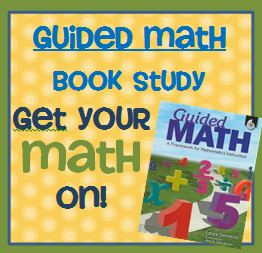This school year has come to an end and my blog will go untouched for the next few months...NOT!!
During my stalking of blogs I came across a book study hosted by Primary Inspired. It started June 8th, better late than never, and each chapter will be discussed by other teacher bloggers. In preperation of my new goal for next year, I will be participating and not allowing my blog to go untouched during the summer. :)
Here are my thoughts...
Guided Math is a framework of 7 instructional components.
- A Classroom Environment of Numeracy - Children think that if they don't understand Math they never will. By creating an environment that supports numeracy, they will see how problem solving and numbers affect their everyday lives and become more meaningful.
- Morning Math Warm-ups - Questions or mathematical tasks are completed by students the minute they are at their desks. I currently use Mountain Math as my warm-up. I won't find out until Chapter 3 what this entails in Guided Math. Hopefully it will be similar to Mountain Math because it will have to blow me away for me to eliminate using Mountain Math. There are so many skills to be learned in Math and it can be difficult to review in January what was learned the previous 4 months. I am so hooked on my warm-up because every week the students quickly review key concepts. They are also introduced to concepts that may not be learned for 2 months, but when the time comes they are already familiar because of the weekly review.
- Whole-Class Instruction - In January, I began the Daily 5 in Math. I cannot wait until they come out with a book on that model!!! Anyway, my whole-class instruction has been in the form of mini-lessons. I'm interested to learn if I am using this method effectively.
- Guided Math Instruction with Small Groups of Students - Who doesn't love working with small groups??? This is my favorite part of the day. I get to differentiate my instruction, provide immediate, corrective feedback, and really get to know my students. I am curious as to how other educators group their students. The book briefly discusses grouping by ability. My groups have always been heterogeneous. I like the idea of having a student with a greater understanding of math in a group with someone who may not. I fear homogeneous grouping for the simple fact of how can they help each other if no one understands? I would greatly appreciate feedback from other teachers on my dilemma :) Again, another chapter that I can't wait to dive into.
- Math Workshop - Great suggestions are made in the book for use in math workshops: math-center activities, math games, Math journal writing, problem of the week. My workshops consist of Math Reading and Writing, Math with Technology, Partner Math, Math by Myself, and Math with IWB.
- Individual Conferences - Excited that this chapter will provide a structure for conferencing and methods for recording anecdotal notes!
- An Ongoing System of Assessment - "In mathematics instruction, a student's level of proficiency can vary drastically from concept to concept." Oh, how so very true! Some students catch on quickly and I don't want to waste valuable time teaching what they already know. On the other hand, I don't want to teach at such a fast pace that the ones struggling are left behind. A balanced system of assessment will give a better picture of each student's understanding.
I have a great deal of information that I am about to learn. I CAN'T WAIT!! Very thankful that I ran across this book study. If I hadn't, I would be skipping around the book and missed out on useful information. More importantly, I would have missed out on valuable insights from other educators.



This book study seems like an exciting journey! Good luck!
ReplyDeleteDuring the last semester, I 'dabbled' with Guided Math in my room. I started out with homogenous grouping. I found, as you mentioned, that the 'lower' groups needed more peer support. So I regrouped. I listed my kiddos top to bottom (readiness), then literally cut the list in half, which left me with two lists: top to middle, & middle to bottom. I then slid the bottom list up so that the top student was paired with the middle student. To make groups of 4 for instance, I took the first two names from the top to middle list & the first two from the middle to bottom list. (Hope this makes sense!!)
ReplyDeleteI found that these groups worked better for both me and the students.
Thanks for linking up!!
Primary Inspired
Ohhhh I am so doing that! Thanks for the idea - very simple but sounds efficient.
ReplyDeletePatti
On The Road To Success
Facebook Page